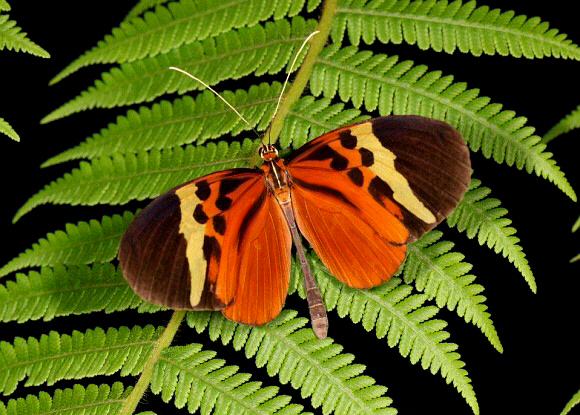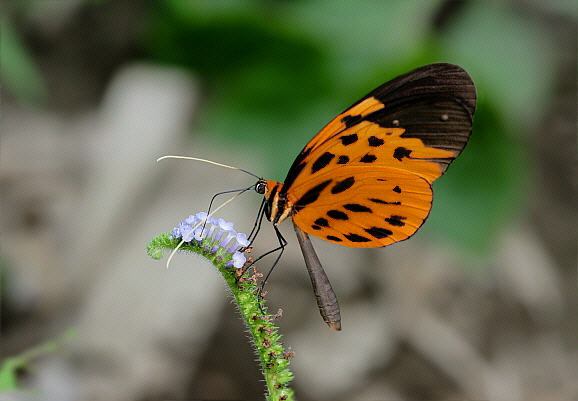
Introduction
The Ithomiini comprises of 376 known species, although it is likely that at least another 30 will be discovered in the near future. All are confined to the neotropical region. Ithomiines are unpalatable to birds, and are consequently mimicked in appearance by many other species. These include other unpalatable species ( Müllerian mimics ), not only from the Ithomiinae but also from several other butterfly families. There are also a large number of edible species ( Batesian mimics ) which have evolved similar patterns. Birds have the ability to memorise butterfly patterns and so learn to avoid eating noxious species, but are also fooled into ignoring similarly marked edible species.
Ithomiines are characterised by having small eyes, slender abdomens and long drooping antennae that lack distinct clubs. Males have a plume of long androconial scales or “hair pencils” on the costa of their hindwings. These are hidden from view when the butterflies are at rest, but are displayed when the wings are held open during courtship. Other Ithomiine characteristics include a very slow and deep wing beat, and a preference for inhabiting the darkest recesses of the forest understorey.
There are basically 2 types of Ithomiine. The first type are the black and orange-banded “tigers”, many of which are mimicked by other species due to their unpalatability to birds. The second type are the “glasswings”, recognised by their transparent or translucent wings, prominent veins, and orange wing margins. Many genera contain examples of both of these types, and in some cases an individual species may produce adults of both forms according to location.
Most novices find the Ithomiini very difficult to identify. Using only the patterns to identify species is very unreliable because there are so many similar species. Also many species produce a variety of different colour forms according to locality and season. The best approach therefore is to use the hindwing venation and other anatomical features to identify the genus, and to then look at the wing patterns to short-list the likely species.
The genus Melinaea contains 11 species, all with similar “tiger” patterning in black and orange. They can easily be confused with other Ithomiine genera such as Athyrtis, Forbestra and Mechanitis but can be distinguished by examining the wing venation, antennae and abdomen as well as the colour and pattern. It’s also possible to confuse Melinaea with certain Heliconius species but the latter have long straight antennae with prominent clubs, while those of Melinaea are cream coloured, gradually tapered, and droop noticeably.
Melinaea menophilus occurs from Panama to Bolivia.

Habitats
Melinaea menophilus is a primary rainforest species found throughout the Amazonian region at altitudes between 0-1200m.
Lifecycle
I have no data regarding menophilus, but the lifecycle is likely to be very similar to that of Melinaea ethra as follows : The egg is white, and laid singly on the undersurface of a leaf. A female will often lay several eggs on each plant visited. Melinaea larvae are similar to those of Lycorea, being white, ringed on each segment with bands of orange-brown or reddish according to species.
The head is striped in black and white, and behind it is a pair long black horizontal filaments that can be moved about at will by the larva. The larval foodplants of Melinaea include Markea, Juanaloa and possibly other Solanaceae.
These plants are toxic, so to avoid being poisoned the caterpillars bite through the leaf veins to demobilise the plant’s defensive compounds before consuming the tissue. The pupa is suspended vertically from a leaf. It is very squat in shape, with compressed abdominal segments, and the thorax is arched back in such a way that the head and wing cases are in a horizontal plane. It is green in colour.
Adult behaviour
The butterfly is active mainly in the early morning, when it can be found visiting flowers in forest clearings and along riverbanks. Later in the day it spends most of it’s time motionless, sitting on leaves in the deep shade of the forest.
Like other Ithomiines, the butterflies spend long periods at rest on the foliage of small shrubs in the darkness of their rainforest and cloudforest habitats. They are extremely nervous, and if disturbed fly immediately, only to resettle on another nearby leaf. The flight is very slow, with characteristic deep wing beats. When feeding in the open they behave very differently – both sexes being very placid and reluctant to leave their flowers.
Males sequester pyrrolizidine alkaloids from Heliotropium, Tournefourtia, Myosotis ( Boraginaceae ), Eupatorium, Neomiranda and Senecio ( Asteraceae ). These chemicals confer toxic qualities to the butterflies which deter bird attacks. The chemicals are also used in the production of pheromones. Often the males of several Ithomiine species will gather together at communal leks, where they release these pheromones from hair-like androconial scales on the leading edge of their upperside hindwings. These attract more males, which in turn release further pheromones.
After a few days the lek may include 50 or more adults comprised of as many as dozen different species. Passing females are attracted to the leks by the complex fragrances. Their presence stimulates the males to open their wings and release further pheromones that entice them into copulation. Females obtain sustenance from nectar, and also visit bird droppings which provide them with a source of nitrogen that assists with the development of their eggs.
